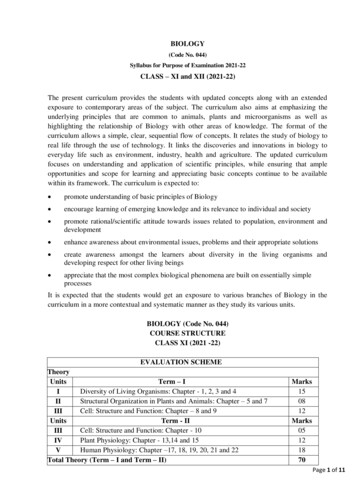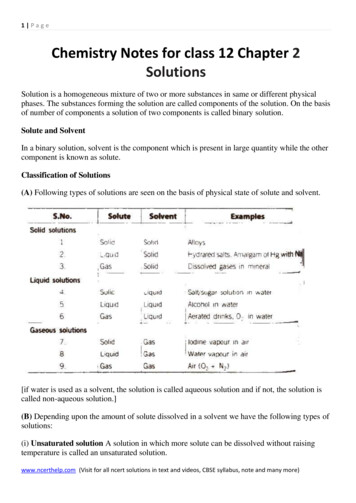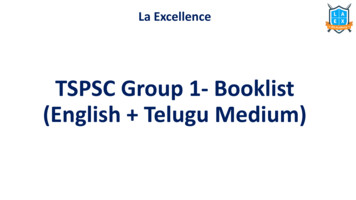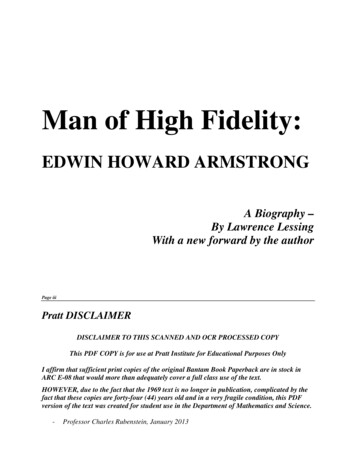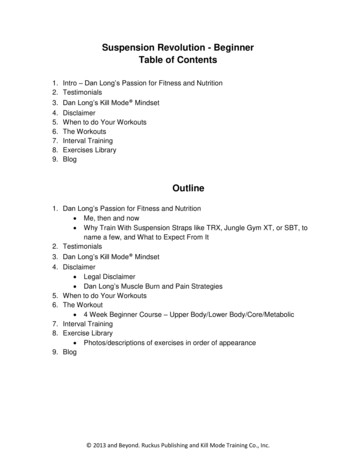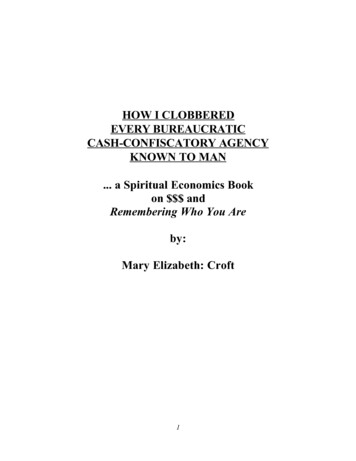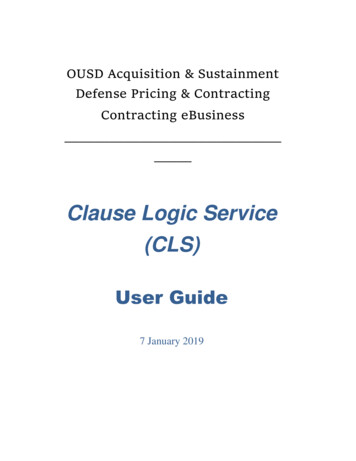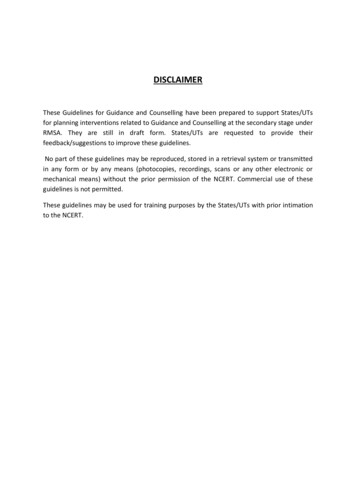
Transcription
DISCLAIMERThese Guidelines for Guidance and Counselling have been prepared to support States/UTsfor planning interventions related to Guidance and Counselling at the secondary stage underRMSA. They are still in draft form. States/UTs are requested to provide theirfeedback/suggestions to improve these guidelines.No part of these guidelines may be reproduced, stored in a retrieval system or transmittedin any form or by any means (photocopies, recordings, scans or any other electronic ormechanical means) without the prior permission of the NCERT. Commercial use of theseguidelines is not permitted.These guidelines may be used for training purposes by the States/UTs with prior intimationto the NCERT.
DraftGuidance and CounsellingGuidelinesforStatesDepartment of Educational Psychology & Foundations of Education&RMSA Project CellNational Council of Educational Research and TrainingSri Aurobindo Marg, New DelhiJanuary, 2015
Contents1.01-3Introduction2. 0 Guidance and Counselling: Indian Scenario4-152.1 A Policy Perspective2.2 Status of Guidance and Counselling Services2.2.1 Position of Guidance and Counselling Personnel2.2.2 Structure of Guidance and Counselling Services2.2.3Roles and Responsibilities of Guidance and Counselling Personnel2.2.4Approaches to Guidance and Counselling3.0 A Developmental Framework for Guidance and CounsellingProgramme in Schools16-234.0 NCERTs’ Attempts Towards Strengthening Guidance andCounselling Services24-275.0 Plan for Operationalizing Guidance and CounsellingServices in States28-3637-48AppendicesAppendix-I An Exemplar Minimum Guidance Programme at SecondaryStageAppendix-II Guidance & Counselling Training MaterialAppendix-III Guidance Resource Centre-DEPFE49BibliographyFor feedback:E.mail : anjumsibia@yahoo.com
IntroductionThe purpose of any education system is not only to foster academic learning but also allround development of children. Besides cognitive development, schooling also involvesappropriate socio-affective development (i.e., self-reliance, self-discipline, takinginitiative, independence of thought, understanding relationships with people andenvironment, responsible action, etc.). Development of suchpersonal-social qualities includes knowledge and understanding, abilities and skills inrelation to oneself and others. The school, besides the family, is a major influence inchildren's personal-social development. As students’ progress through primary andsecondary stages of schooling, they need an environment that is secure, warm, caring andnurturing. Teachers in order to foster personal-social competence need to develop anunderstanding of their students and ensure that all students are treated fairly, are valued,and are exposed to a wide range of personal and social learning experiences.Education aims at promoting optimum development of students in all spheres –educational, vocational, personal, social, moral, physical etc. so as to make themproductive and useful citizens. Guidance and counselling in harmony with the goals ofeducation, aims to facilitate maximum personal development of children in all spheres oflife. In its attempt to meet the needs of all students, guidance and counselling makeseducation a meaningful and satisfying experience. Learning and understanding about selfis as important as learning about various school subjects. Every child has the potential todevelop self-understanding which includes understanding of abilities, interests,behaviours, attitudes, values, conflicts, anxieties, likes, dislikes, impulses / emotions,goals, one’s role in society etc. The National Curriculum Framework (NCF, 2005) viewsGuidance and counselling as part of curriculum. In this view guidance and counsellingfunctions can be carried out through the curriculum by integrating guidance philosophyand practices through curricular offerings thereby adopting a proactive and preventiveapproach. Educational, career and personal-social development of childrencan bepromoted by creating stress-free environment for learning, encouraging students tounderstand themselves, relating subject matter to self and needs of students, helpingchildren learn independentlyand cope with demands and challenges, facilitatedevelopment of healthy peer relationships through group activities and classroom climate,etc.1
The need for guidance and counselling for students emerges from the changes takingplace in every sphere of life. Academic stress, poor academic performance, cut-throatcompetition, vast and varied educational and career opportunities and resulting confusionin making career choice, ever growing, changing and complex world of work, drop-out,suicide, anger, violence, drug abuse, child abuse, sex abuse, HIV/AIDs, crime, changes inlifestyle, divorced / single parents etc. are some of the concerns which require support ofguidance and counselling services to school students. Helpline for students by variousorganizations like CBSE, few State level guidance agencies, NGOs etc. and popularity ofthese helplines point towards the need and significance of guidance and counsellingrequirement for the school system.To address the developmental needs and concerns of students at different stages ofschooling, a professionally trained person, a counsellor or a teacher-counsellor is requiredto work within and with the system. The purpose of guidance and counselling services isto help each student develop as an individual in his/her own right, make choices and setgoals on the basis of his/her strengths. By attending to the special needs and requirementsof students belonging to different social, economic and cultural backgrounds, guidanceand counselling helps students engage in the educational process and, thereby, benefitfrom the curricular experiences. Guidance and counselling not only helps students todevelop an understanding of one self and of others, it also supports students to deal withtheir personal- social, academic and career related concerns. It facilitates development ofeffective study habits, motivation, identifying learning or subject related problems,helping students to see the relevance of school years in life and for future, developingskills, right attitude and interests to help making a choice in career etc. Guidance andcounselling, thus, promotes holistic development of every student. This signifies the needfor every teacher to become a ‘guidance minded’ teacher and carry out his/her functionswith guidance aim.Rashtriya Madhyamik Shiksha Abhiyan (RMSA) envisions equipping the State personnelwith skills and competencies to facilitate educational, personal, social and careerdevelopment of students. It is of immense significance and needs to be taken forward.The proposed guidelines would provide a road map to implement this vision and take it tothe States. The document begins with a brief on need of guidance and counselling insupporting overall development of children, followed by presenting a historical view ofguidance and counselling concerns as reflected in policy documents and the status,approaches etc. of these services in the country. In view of the developmental nature of2
guidance, a broad general developmental framework to undertake guidance andcounselling programme in schools is given, which would need to be contextualisedaccording to the needs and concerns of the students. This is followed by what do schoolsneed to focus on to guide students at secondary stage? An exemplar guidance programmedrawn for secondary stage provides a view of what can be taken up by schools. Theattempts made at national level to strengthen Guidance and Counselling services in thecountry states are presented next. This is followed by a plan to operationalize guidanceand counselling services in states, the roles and responsibilities of the organisations atnational, state, block and school levels are delineated with respect to academic,infrastructural and training components. A few exemplars of the course material are alsoappended.3
2.Guidance and Counselling: Indian ScenarioIn attempts towards strengthening guidance and counselling services in the country, ahistorical summation is imperative. A view of guidance and counselling is provided asarticulated in various policy documents, advances in establishment of guidance andcounselling services across the states, existing status, locale, structure, functions andapproach to offering guidance and counselling services.2.1 A Policy PerspectiveA relook at guidance and counselling, as emphasized in various policies/curriculumframeworks, indicates that concern for providing guidance and counselling services inschools for school students has continued throughout the years after independence. Theprovision of guidance services by trained personnel or counsellors, or teachers andtraining of teachers for the purpose has also been emphasised. A number of EducationCommissions and Curriculum Frameworks have laid special emphasis on guidance andcounselling in school education. A brief look at the recommendations is mandated toaugment efforts in this direction.Secondary Education Commission (1952-53) of Education, the first EducationCommission in independent India also known as Mudaliar Commission, recognized theimportance of proper guidance for students as part of education. The specificrecommendations included:(i) establishment of centres in different regions of the country for training of guidanceofficers and career masters, and (ii) Central Research Organization for carrying outresearch in educational and vocational guidance. As an outcome of the recommendationsof the Commission Central Bureau of Educational and Vocational Guidance (CBEVG), aCentral agency, was set up in 1954 under Ministry of Education and several such bureausat state level also. Establishment of All India Educational and Vocational GuidanceAssociation in 1956 was a result of this. This gave impetus process to the idea ofproviding guidance services in the country in an organized manner.Education Commission (1964-66) expanded the scope of guidance services beyondeducational and vocational guidance. Guidance was viewed as both adjustive anddevelopmental; therefore it was regarded as an integral part of education and not a special4
psychological or social service peripheral to educational purpose. Guidance, therefore,was seen as a continuous process aimed at assisting the individual to make decisions andadjustments from time to time (9.43-45 (p.238).A detailed framework of guidanceservices describing the functions and strategies of guidance at primary and secondaryschool stages as well as training of guidance functionaries was given. It recommendedguidance at the Primary Stage “to begin from the lowest class of the primary school tohelp pupils make satisfactory transition from home to school; to diagnose difficulties inthe learning; identify pupils in need of special education (e.g., the gifted, the backward,the physically handicapped); and to guide pupils to develop insight into the world of workand favourable attitudes towards work” (9.44-45, p238-239). Guidance at the SecondaryStage aimed to identification and development of the abilities and interests of adolescentpupils. The emphasis was laid on trained counsellor to provide guidance services in allsecondary schools. However, it also recommended adopting a short-range programmeconsisting of (i) A minimum guidance programme for all secondary schools through avisiting school counsellor assisted by the school teachers in the simpler guidancefunctions; (ii) Comprehensive guidance programme in selected schools (one in eachdistrict) to serve as models; (iii) Provision of necessary supervisory staff in the StateBureaus of Guidance to inspect and offer consultation to the school workers; and (iv) Allsecondary school teachers to be introduced to guidance concepts through pre- or inservice training ( 9.46 – 50, p.238).National Policy of Education (NPE, 1986) and Programme of Action (POA, 1992) linkedguidance services with the vocationalization of education and the POA (1992) statedemphatically the need for a parallel infrastructure of guidance and counselling: “thecentrally sponsored scheme envisages that vocational guidance will be available in theschool for providing necessary guidance to the students, parents and teachers regardingsuitable educational and vocational choices. The guidance programme should bedirected at informing the students about job opportunities in various courses, facilitiesfor on-the-job training and placement by working in collaboration with employees”(p.109). The policy also recommended responsibility of Vocational Guidance Teachersfor general foundation course and appointment of trained counsellor at district level (atstate’s cost) to organize career advise centre and existing bureaus to train teachers. Laterthe revised scheme of Vocationalisation of Secondary Education (VOSE) (1993)suggested that Vocational Guidance Teacher (VGT) be appointed in each school for thepurpose.5
National Curriculum Framework for School Education (NCFSE, 2000) mentionedguidance services mainly for providing assistance to students for choice of courses andselection of a suitable career required at school leaving stage and not as an intervention tofacilitate holistic development throughout the school years. Accordingly, NCFSE laidstress on provision of a guidance counsellor for every higher secondary school and onevisiting school counsellor for a cluster of 3 to 4 secondary schools. In addition, it also laidstress on providing a career teacher for each secondary school wherever counsellor couldnot be appointed.National Curriculum Framework (NCF, 2005) provided guidelines for facilitating healthygrowth and development of students across are school stages and scope for guidance /counselling at each of these school stages from elementary through secondary and highersecondary stages. Recognizing the elementary school years as one of tremendouscognitive and affective development, NCF advocates the teacher’s guidance approach :“Teachers with background in guidance and counselling can design and lead activitiesto meet the developmental needs of children, thus laying the foundation for necessaryattitudes and perceptions towards self and the world of work. They can also provideneeded support and guidance to children belonging to various groups and strata ofsociety for their sustenance through the elementary school areas” (p.68).At secondarystage NCF states : “The courses at this level generally aim at creating an awareness ofthe various disciplines and introduces students to the possibilities and scope of study inthem. Through such engagement, they also discover their own interests and aptitudesand begin to form ideas on what courses of study and related work they might like topursue later. Such needs could be effectively met by Guidance and Counsellinginterventions of an organized nature with support of trained teachers and professionalcounsellors”(pg.68).Further focusing on Higher Secondary stage NCF states: “Given the developmentalnature of this stage, guidance and counselling by trained professionals must be madeavailable to children. Interventions to enhance self/career awareness, career explorationand planning are also essential. Besides, this stage coincides with adolescence, a periodin an individual’s life that is marked by personal, social and emotional crises created dueto the demands of adjustment required in family, peer group and school situations. Theprovision of these services in schools would help create the support system required tocope with increasing academic and social pressures” (p.70). NCF emphasizes that6
teacher education should develop the needed counselling skills and competencies to be a‘facilitator’ and ‘helper’ of children needing specific kinds of help in finding solutionsfor day-to-day problems related to educational, personal and social situations. (108). Inthe context of ‘Reducing stress and Enhancing Success in the X and XII publicationexamination’ (p.113) it emphasizes G&C be made available in schools to deal with stressrelated problems and to guide students, parents and teachers to lessen the students stress.Help lines in boards can also help students and parents”.To meet the desired goals of guidance and counselling services the NCF delineates theresponsibilities of states to augment guidance and counselling services. “The roles andfunctions of SCERTs need to include providing support not only in purely academic areasbut psychological aspects as well. SCERTs must take steps to strengthen the guidancebureaus/units already existing with them by setting them up as resource centres at thestate level for in-service teacher training in this area, production of psychological tools/tests, career literature, etc. and make counselling services available at district/block andschool levels by positioning professionally trained guidance personnel.”(pg 56.1, p. 12)Rashtriya Madhyamik Shiksha Abhiyan (RMSA, 2012) a recent initiative of governmentof India committed to Universalize Secondary Education at Secondary and HigherSecondary stage lays emphasise on guidance and counselling as one of the importantareas to achieve the goals of USE, quality concerns and improvement in education atsecondary stage. As mentioned below:“Guidance and Counselling, both as an approach and as service, will be an importantstrategy for promoting Universalization of Secondary Education in terms of its pro-activeas well as remedial role. Guidance and Counselling services can help in promotingstudents’ retention and better scholastic performance in curricular areas, facilitatingadjustment and career development of students, developing right attitudes towardsstudies, self, work and others”.Counsellors, especially trained in theory and practice of counselling, can guide thestudents and help them develop the right attitudes and competencies to cope witheducational, personal, social and career related problems and issues. The provision ofthese services in schools particularly at this stage would help students cope withincreasing academic and social pressures. A multi-pronged strategy is needed to makeavailable guidance services at school stage across the country”.7
In an attempt to make available guidance and counselling services to school students,RMSA has laid stress on strengthening of state level guidance agencies and appointment /utilization of trained guidance personnel and in service training / orientation programmesand has made the following suggestions:i.Strengthening the existing, Bureaus of Guidance, by adequate staffingtraining provision, resource materials and other aids for effectiveimplementation. Appointment of full time school counselors of PGT levelby the state government and UTs. at cluster/block/district level” (5.10.3).ii.Every school to have at least one teacher and preferably two (one male andone female) teacher trained in guidance and counselling.Teacher-Counsellors already trained should be utilized for extending trainingfurther at state level. (5.10.4).iii.The Guidance and Counselling should be an essential part of pre serviceand in-service training programme for teachers and principals/viceprincipals (5.10.4).iv.Every State Department of Education / State Bureau of Guidance isexpected to ensure creating a cadre of trained guidance personnel asGuidance Officers. (5.10.5).v.Sensitization programmes for Principals/Heads of Schools at state leveland enrichment programmes for trained guidance personnel should be aregular feature (5.10.6).vi.The schemeprovides funds to states for strengthening of GuidanceBureaus for appointment of staff, development of Guidance ResourceCentre and organizing programmes such as : Strengthening of guidance Bureaus / filling up of five posts in 35States / UTs. 5 persons @2.4 lakh per person per year, Setting up of Guidance Resource Centre (funds for psychological tests/ tools, guidance / career literature, display materials etc.) @Rs.50,000/- per State, Resource Persons/Research Assistant for development work/field work@Rs.1.0 lakh (Salary TA/DA Contingency),8
Sensitization programmes (2 days) for Principals (35-40) by StateBureaus @Rs.40,000/- per programme per state for 35 States pluscontingency (5.10.7)It is evident that the need for guidance and counselling services has been well articulatedin the policy documents for a long time .Even though these services have been introducedin the school system and have also advanced to some extent, they are far from beingadequate to meet the growing needs of students across the states.Keeping in view of that now funds are made available by the central government underRashtriya Madhyamik Shiksha Abhiyan (RMSA) for strengthening guidance andcounselling services, attempts need to be made by the state bodies and concerned statelevel educational administrators to strengthen the existing or establish new state levelguidance and counselling set ups.2.2 Status of Guidance and Counselling ServicesGuidance and Counselling services across the states in the country have been offeredsince long. Early the beginning of the services can be traced back to the year 1947. The“Bureau of Psychology (Manovigyan Shala)” was established in Allahabad in 1952-53the Central Bureau of Educational and Vocational Guidance (CBEVG) was set up at theCIE, Delhi under the Centrally Sponsored Scheme of the Government.The department continuously updates the status of guidance services in the country; theinformation is collected by sending a questionnaire. In the past NCERT has beencollecting information about the guidance bureaus / cells from time to time by conductingstatus survey of guidance and counselling services (1981, 1993), organising AllIndia Conferences of State Bureaus during the years 1976, 1982, 1985, 1989, 1992, 1998;creating data base of guidance services and resource persons during 2005-07 and thelatest update of these services was conducted during May – November, 2011.At present(during 2014) the process of updating information has been initiated and information isawaited .A glimpse of the developments in the establishment of guidance and counselling servicesacross the states and their status is given in the following Table-1.9
Table-1 Status of State Level Guidance AgenciesS.No.State/U.T.Set up/Name/OrganisationYear ofReported Status up toEstablishme2012nt1.Andhra PradeshState Bureau of Educational and1957Vocational Guidance (Hyderabad)(Existed till 2007)Latest information notrecd.2.AssamBureau of Educational and Vocational1957Guidance (Shillong)(Existed till 2007)Latest information notrecd.3.BiharBureau of Educational and Vocational1956Guidance (Patna)Guidance unit underDepartment of TeacherEducation, SCERT4.GujaratInstitute of Vocational Guidance1956(Ahmedabad)(Existed till 2007)Latest information notrecd.5.KeralaBureau of Educational Research and1960Services (Trivandrum)6.Guidance Unit atSCERTMadhyaBureau of Educational and VocationalPradeshGuidance (Jabalpur)1956(Existed till 2007)Latest information notrecd.7.MaharashtraInstitute of Vocational Guidance1950Bureau at MSCERT1959(Existed at DSERT till(Bombay)8.KarnatakaBureau of Educational and VocationalGuidance (Bangalore)2007)Latest information notrecd.9.OrissaState Bureau of Educational and1955Vocational Guidance (Cuttack)(Existed till 2007)Latest information notrecd.10.PunjabState Bureau of Educational andVocational Guidance (Chandigarh)101962SBERG at SCERT
11.RajasthanState Bureau of Educational and1958Guidance unit at SIERT1947Independent Bureau1953(Existed till 1981)Vocational Guidance (Bikaner)12.Uttar PradeshBureau of Psychology (ManovigyanShala) (Allahabad)13.West BengalBureau of Educational andPsychological Research (Calcutta)Latest information notrecd.14.Arunachal--( Not established)--Guidance Bureau atPradesh15.ChattisgarhSCERT16.Delhi--SBEVG under DOE17.Goa--(Existed till 2007 atDIETLatest information notrecd.18.Haryana--(Existed till 1997)19.Himachal--(Existed till 1997)--(Not Never established)22.Manipur--Guidance Cell am--Guidance unit atSCERT25.Nagaland--Guidance cell atSCERT26.Sikkim-( Not established)27.Tamil Nadu--(Existed till 2007 atDTERT)11
No information28.Tripura--None (Existed till1985)29.Uttarankhand--Guidance unit atSCERT30.Andaman &--NicobarNoneLatest information notrecd.31.Chandigarh--Guidance unit at SIE32.Dadra & Nagar--( Not established)Haweli33.Daman & Diu--( Not established)34.Laksadweep--( Not established)--(Existed till 2007 at(UTL)35.Pondicherrystate training centre,Directorate of SchoolEducation)Latest information notrecd.*The above table is based on the information received in the department up to 2012.Even though attempts have been made over the years, the status of state level guidanceagencies (Table-1) shows that the guidance and counselling cells/bureaus are either notestablished or are performing a limited role. Only a few fully functioning cells/bureausexist .This highlights the need to explore the possibilities to strengthen the cells/bureausexisting in a different way.The attempts made across the states in supporting / establishing state level guidanceagencies have highlighted the variations that exist with regard to their setting, name,structure, functions and approach to offering guidance and counselling services. A brieflook at these aspects:12
2.2.1 Position of Guidance and Counselling PersonnelThe positions of personnel providing guidance services are stated under different namesat different level in the states, districts, blocks and schools. Some of these are :a. At state level: Lecturers (Psychology), Vocational Guidance Officers (VGOs) ,Psychologists, Psychometrician, Occupational Information Officers, TechnicalAssistants or Counsellorsb. At district level : District Guidance Counsellorsc. At school level: Counsellors, Teacher-Counsellors, Career Teachers2.2.2Structure of Guidance and Counselling ServicesGuidance and counselling services are organised through a number of channels. Some ofthese are:a. State level guidance agencies in the form of State Bureaus of Educational /UnitsinSCERTs/SIEs/DoEs or sometimes in DIETs.Employment Exchanges / University Employment Information and Guidanceb.Bureaus.c.Guidance and Counselling Cells in Psychology/Education Departments ofUniversities and Colleges / Counsellor Training Institutions.d.Child Guidance Clinics.e.Vocational Rehabilitation Centres.f.NGOs / Private Practitioners.2.2.3Roles and Responsibilities of Guidance and Counselling PersonnelThe functions of guidance and counselling personnel commonly pertain to the following:a. Planning, coordination and supervision of guidance services within the states.b. Training of guidance personnel such as career teaches’ training programmes.c. Preparation, development or translation of tests and tools of assessment.d. Conducting research on various problems in the field of guidance.e. Collection, classification, production and dissemination of career information.f. Publication of suitable guidance materials in the regional language for the use ofstudents, parents and teachers.13
g. Providing consultancy and field service.2.2.4Approaches to Guidance and CounsellingGuidance and counselling in the country is offered using different approachesdepending upon the kind of programmes organized (in schools) and the personnelengaged in imparting guidance and counselling services. In view of the services offered,these approaches may be grouped as: Specialist Approach, Career Teacher Approach, andTeacher Counsellor Approach.Specialist ApproachThe Guidance and counselling services are viewed as specialized in nature and, therefore,are provided by a full-time professionally trained counsellor in school, from elementaryto higher secondary school stage. The counsellor is a full-time appointed personresponsible for guidance and counselling in school and plans and organizes guidance andcounselling activities keeping in view the needs and specific concerns of students. Thetrained counsellor seeks the support of all the stakeholders like principals, teachers,parents, community, administrators, etc. in the programme and also organises orientation/ sensitization workshops for them.In our country, services of full-time counsellors are available in a few governmentand private schools only. Some schools utilize the services of professionally trainedcounsellors on part- time basis or as visiting counsellors.Career Teacher ApproachIn many states, guidance bureaus / cells train (and continue to do so) teachers to take upcareer work as a part of their teaching work or as additional work. The emphasis is oncollection of career information and its dissemination to students especially at secondaryand higher secondary stage. The career teachers are trained in short-term training of 3-4weeks, emphasising collection of information from various sources, organization of groupactivities and display for dissemination of career information. They perform limitedfunctions only related to career information and guidance.Career Teacher Model has been widely accepted in the country. Association of careerteachers with guidance has its genesis in the introduction of guidance services in theschools. The need of the present times is on building the capacities of every teacher asguidance minded teacher. Since career, academic and personal-social concerns ofstudents are important and need to be appropriately addressed; training of every teacheraddressing all these concerns is envisaged under RMSA.14
Teacher Counsellor ApproachIt is premised that every teacher has a Guidance role and can provide guidance andcounselling services to students. To be teacher counsellors, teachers undergo professionalcounsellor training programme to develop/enhance the desi
Department of Educational Psychology & Foundations of Education & RMSA Project Cell National Council of Educational Research and Training Sri Aurobindo Marg, New Delhi January, 2015. Contents 1.0 Introduction 1-3 2. 0 Guidance and Counselling: . counselling programme in sc



